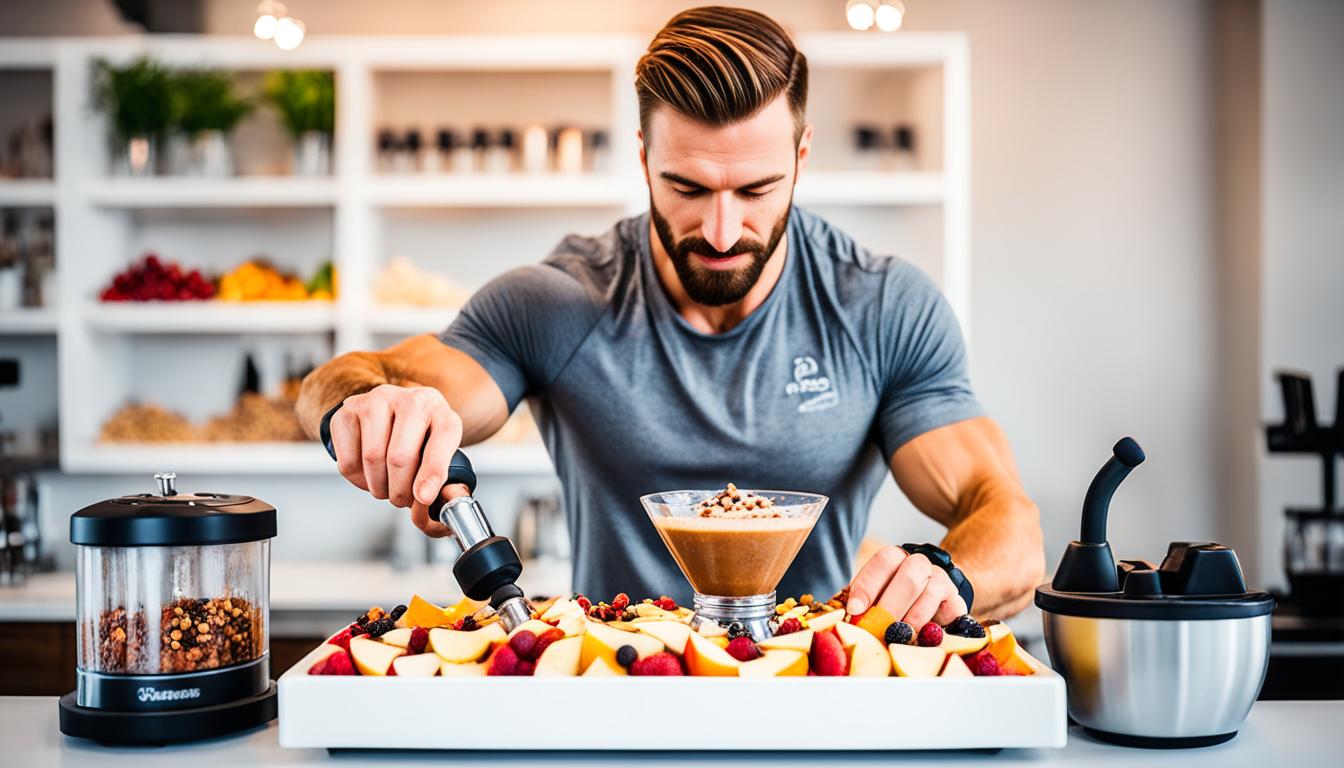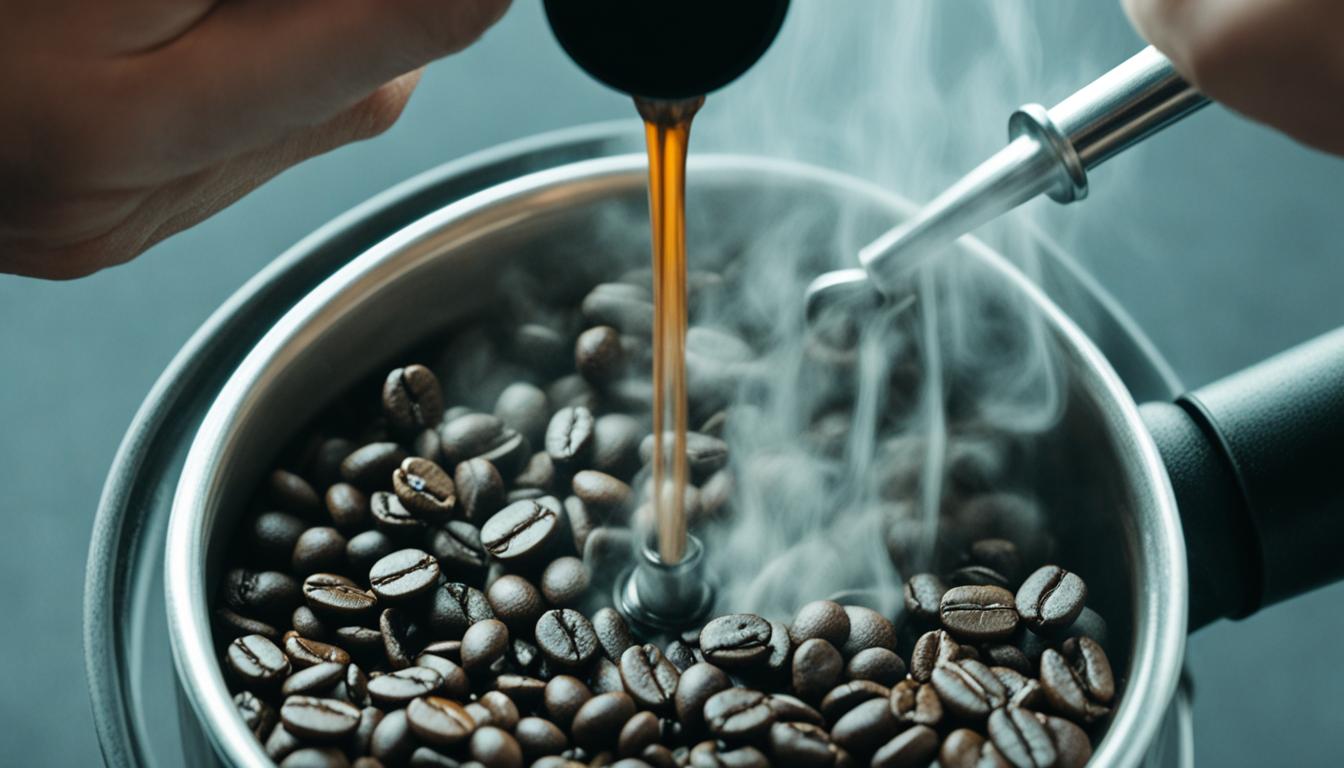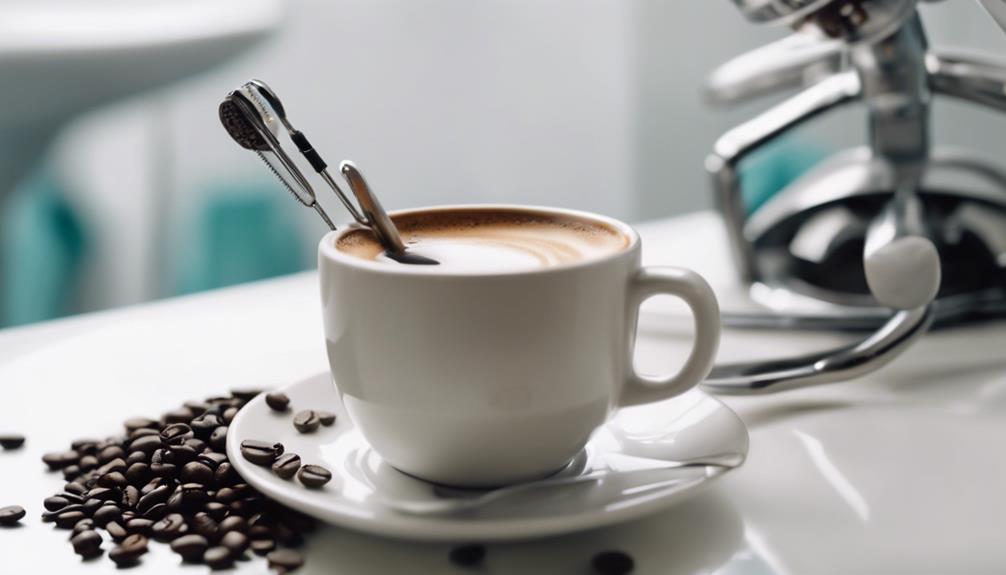Did you know that drinking two 8-ounce cups of coffee before working out can make the experience more enjoyable? This is especially true for fitness enthusiasts. Coffee not only boosts your mood and motivation but also enhances your performance by boosting endurance and energy levels.
The trend of pre-workout coffee recipes is growing fast. Now is the best time to see how coffee can boost your exercise routine. By having caffeine before working out, athletes can burn about 15 percent more calories. Whether you hit the gym occasionally or train rigorously, adding a coffee protein shake can heighten your gains and pleasure.
Why not try coffee that is both delicious and nourishing? Our pre-workout coffee recipes range from rich creamy mochas to cool iced coffees. They are made for those aiming to elevate their gym performance. Explore and find the ultimate drink to energize your training sessions.
Key Takeaways
- Two cups of coffee before a workout can enhance enjoyment and performance.
- Caffeine can increase calorie burn by approximately 15% post-exercise.
- Pre-workout coffee recipes can help athletes draw extra energy.
- Coffee protein shakes provide essential protein alongside the benefits of caffeine.
- Customization in caffeine consumption is key based on individual fitness goals.
The Benefits of Coffee for Fitness Enthusiasts
Coffee is a favorite among fitness lovers because of its benefits. It is packed with caffeine, giving a huge energy lift. This boost helps increase focus and energy during exercise. Drinking coffee before working out can lead to better performance and more stamina.
Energy Boosting Effects of Caffeine
Caffeine acts as a strong stimulant for both the mind and body. Drinking 3-4 cups of cold-brew coffee each day improves strength and endurance. Cold brew has more caffeine than hot coffee. So, it’s great for those needing an extra kick. It fights off tiredness, makes muscular fatigue less noticeable, and makes exercises seem easier.
Improved Endurance and Performance
Caffeine’s positive effects on workout performance are proven. It boosts stamina and power, helping in all types of training. One study shows people doing better in muscle endurance, strength, and speed after having caffeine. Cold brew coffee’s antioxidants help with health, offer anti-inflammatory benefits, and might protect against some diseases.
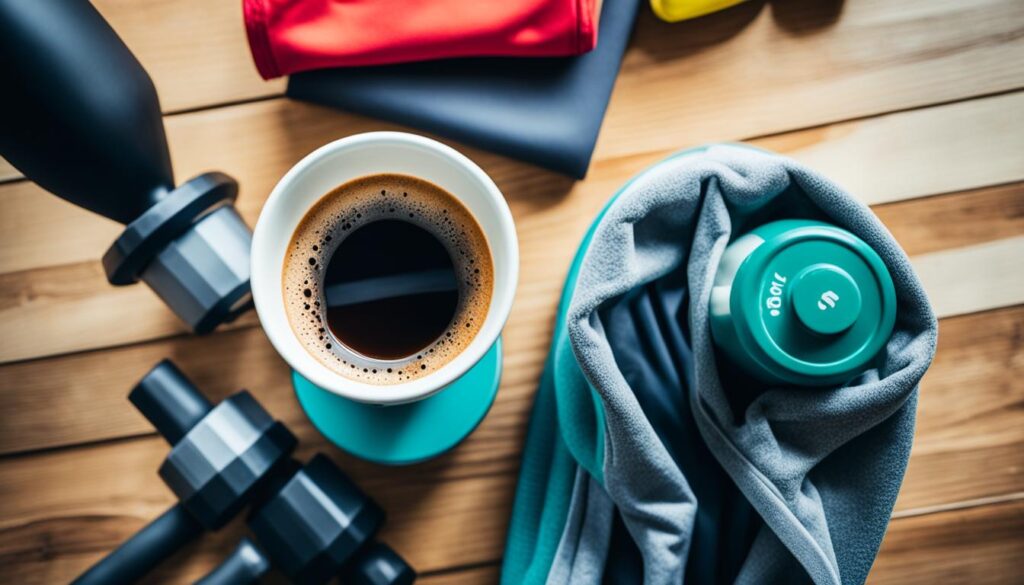
| Benefit | Description |
|---|---|
| Increased Energy | Caffeine enhances energy levels, reducing fatigue during workouts. |
| Improved Stamina | Caffeine consumption boosts endurance, allowing for longer workouts. |
| Higher Strength Output | Participants show increased power outputs with caffeine intake before exercise. |
| Enhanced Focus | Caffeine improves mental clarity and concentration during physical activity. |
| Antioxidant Benefits | Cold brew coffee offers higher concentrations of antioxidants, promoting overall health. |
Understanding Coffee and Fitness: Best Pre-Workout Coffee Recipes
Coffee is a fantastic coffee pre-workout drink. It wakes up both your mind and body. The caffeine in coffee kick-starts your central nervous system. This boosts your focus and energy, helping you do better in your workouts. Fitness lovers choose coffee for a reason. It mixes well with nutritional benefits of coffee and protein for pre-workout drinks.
Why Coffee Works as a Pre-Workout Drink
Coffee has about 120mg of caffeine per cup, giving you a good energy boost. If you need a quick hit, a single espresso shot has around 63mg of caffeine. It’s perfect in small amounts. You should have 200-400mg of caffeine if you weigh about 68kg (150 pounds) before exercising. This is because it takes about 30 to 90 minutes for caffeine to fully work. So, plan your coffee time right before your workout.
Key Nutritional Benefits of Combining Coffee and Protein
Mixing coffee with protein brings more health perks. Using Collagen Protein Powder is great. It gives you 11 grams of protein from just two tablespoons. This helps your muscles repair and keeps you full for up to 6 hours. It’s perfect before morning exercises. Coffee’s antioxidants aid muscle recovery too. Elements like trigonelline can even help fight diseases like type 2 diabetes. By adding the best coffee recipes with protein and healthy fats, like in coconut milk, you get a superb drink. It helps you give your best performance.

A Guide to Crafting the Perfect Coffee Protein Shake
Creating a delicious coffee protein shake is all about choosing the best ingredients and mixing them well. This drink blends the boost from coffee with healthy nutrients. It’s ideal for before or after your workout.
Essential Ingredients for Your Shake
For the perfect coffee protein shake, focus on these must-have ingredients:
- High-quality brewed coffee – Pick your favorite, like espresso, drip, or cold brew.
- Protein powder – Choose from whey, plant-based, or collagen types, depending on your diet.
- Unsweetened almond milk – Half a cup makes it creamy without too many calories.
- Flavor enhancers – Think about adding almond butter, cocoa, honey, or maple syrup for better taste and health benefits.
- Fruits – Bananas, berries, or mango can make your shake tastier and more nutritious.
Tips for Blending Your Shake to Perfection
Try these blending tips for the best coffee protein shake:
- Begin at a slow speed to mix liquids and protein powder well.
- Then, speed up to get a smooth texture.
- Adding ice or frozen fruit makes your shake cooler, perfect for hot days.
- Try different flavors like Mocha Madness or Vanilla Latte Love for variety.

This guide shows how simple it is to make a tasty coffee protein shake. It can meet your taste and nutrition needs easily.
Refreshing Iced Coffee Protein Shake Recipe
This delightful iced coffee protein shake is perfect for warm summer days. It is full of flavor and nutrition, ideal for anyone needing a quick boost before or after their workout. With step-by-step shake preparation, making a delicious drink is easy.
Ingredients Needed
- 1 cup of cooled coffee
- 1 ½ cups of coffee ice cubes
- ¾ cup of almond milk (or whole milk)
- 1 frozen banana
- 1 scoop of chocolate protein powder (or preferred flavor)
- 1-2 tablespoons of raw honey (optional)
- 1 tablespoon of almond butter
- Chia seeds, cocoa powder, or cinnamon for optional flavoring
Step-by-Step Instructions for Preparation
- Start by brewing coffee, then let it cool down.
- Next, pour the cooled coffee into an ice cube tray and freeze until solid.
- Then, in a blender, mix the coffee ice cubes, almond milk, frozen banana, protein powder, and almond butter.
- Keep blending until you get a creamy texture.
- You can also add chia seeds, cocoa powder, or cinnamon for more flavor.
- Give the mixture a taste. If you like, make it sweeter with raw honey.
- Finally, pour the shake into glasses and drink it right away for ultimate refreshment.
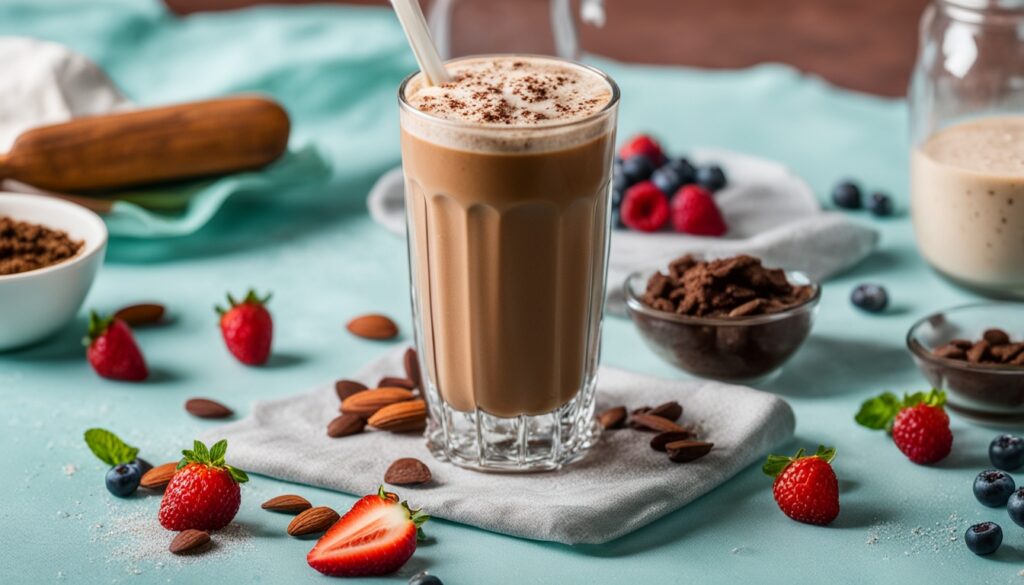
This iced coffee protein shake gives you 20 grams of protein per serving. It’s a great choice for your fitness goals. With just 1.4 grams of net carbs, it suits a low-carb diet too. Make this shake a favorite refreshing coffee recipe to stay cool and full of energy.
Mocha Delight: A Rich Coffee Protein Blend
The Mocha Delight is a top pick for those who love mocha and want a protein shake. It’s packed with flavor. This shake mixes coffee’s bold taste with chocolate’s sweetness. It gives you energy and nutrition. It’s perfect before exercising or when you want something yummy.
Ingredients for Mocha Lovers
- 1 cup brewed coffee (cold or hot)
- 1 scoop chocolate protein powder
- 1 tablespoon unsweetened cocoa powder
- 1 cup milk (dairy or non-dairy)
- 1-2 teaspoons honey or maple syrup (optional)
- Ice cubes (for a refreshing effect)
Recipe Instructions for a Tasty Treat
- Begin by brewing a cup of your favorite coffee and allow it to cool.
- In a blender, combine the cooled coffee, chocolate protein powder, unsweetened cocoa powder, and milk.
- Add honey or maple syrup for sweetness, if desired.
- Include ice cubes for a chilled shake.
- Blend until smooth and creamy. Adjust the thickness by adding more ice or milk as needed.
- Pour into a glass and enjoy this delightful mocha coffee protein shake!
This mocha delight is among the top rich coffee recipes for adding protein to your diet. You can customize it in many ways. Try different milks or add nut butter. It pleases your taste and supports your fitness goals.
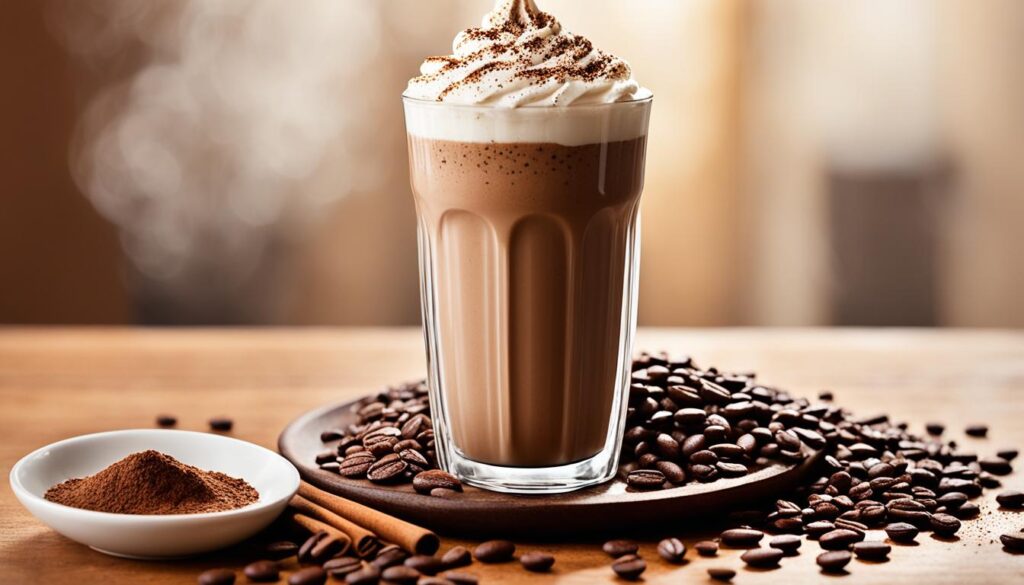
| Shake Type | Protein Content (grams) |
|---|---|
| Vanilla Coffee Shake | 66 |
| Chocolate Coffee Shake | 59 |
| Cinnamon Roll Shake | 25 |
| Breakfast of Champions Shake | 47 |
| Almond Blast Shake | 80 |
| Peanut Butter Banana Shake | 65 |
| Personalized Protein Shake | 159 |
Nutrition-Packed Banana Coffee Smoothie Recipe
This banana coffee smoothie blends flavors and nutrients in a tasty way. It’s perfect for those who want a healthy pre-workout drink. Bananas, with their natural sweetness, match the rich coffee taste well. This mix boosts the smoothie’s flavor and health benefits. With lots of potassium, bananas aid muscle function. They pair well with the energy boost from coffee.
Why Bananas Complement Coffee
Bananas bring lots of banana benefits, like lasting energy from their carbs. Their potassium helps keep a good electrolyte balance during exercise. Coffee’s caffeine gives a necessary kick. Together, they make a revitalizing drink that’s great before a workout.
Ingredient and Preparation Guide
Making this banana coffee smoothie is easy and fast. It only takes about five minutes. Here’s what you need:
- 1/2 cup unsweetened almond milk or your favorite milk
- 1/2 cup freshly brewed coffee or cold brew
- 1 frozen banana
- 1/2 tablespoon chia seeds
- Optional: 1 scoop protein powder (e.g., collagen peptides)
- Optional: 1 teaspoon maple syrup, honey, or your choice of sweetener
- Optional: Handful of ice cubes for thickness
This recipe makes enough for two. It has an impressive 4.85 rating out of 5 from 20 votes. This shows its popularity with smoothie lovers.
To make the smoothie:
- Put all the ingredients in a high-quality blender, like a Vitamix.
- Blend on high until smooth. Adjust thickness with more ice or milk if you like.
- Try it and add sweetener if you think it needs it.
- Pour it into glasses to enjoy now or keep for later. You can freeze smoothie packs and have them ready for up to a month.
Each serving has these nutrients:
| Nutrient | Amount |
|---|---|
| Calories | 96 kcal |
| Carbohydrates | 15.5 g |
| Protein | 6.2 g |
| Fat | 2.3 g |
| Saturated Fat | 0.3 g |
| Sodium | 101 mg |
| Fiber | 3 g |
| Sugar | 7.2 g |

Nutty Coffee Protein Shake Variations
Trying different nut coffee shake variations can be both tasty and healthy. Adding various nut butters, like almond, peanut, and cashew, makes it better. They bring unique flavors and health perks to your coffee protein shake. Using nut butters boosts the taste and packs in nutrients for your health.
Customization Ideas with Nut Butters
Nut butters offer many benefits. They’re a great source of healthy fats and make your smoothie creamy. Here are some fun ways to mix nut butters into coffee protein shakes:
- Almond Butter Delight: Add a tablespoon of almond butter for extra nuttiness and energy.
- Peanut Butter Protein Punch: Throw in some peanut butter for a filling and creamy shake.
- Cashew Creaminess: Use cashew butter for a mild flavor boost and extra creaminess.
- Hazelnut Flavor Fusion: Mix in hazelnut butter for a rich taste that goes great with coffee.
Playing with these ideas can spark your creativity in the kitchen. These nut coffee shakes are not only delicious but nutritious. Try adding your preferred nut butter to a protein shake and enjoy the great taste and health perks yourself.
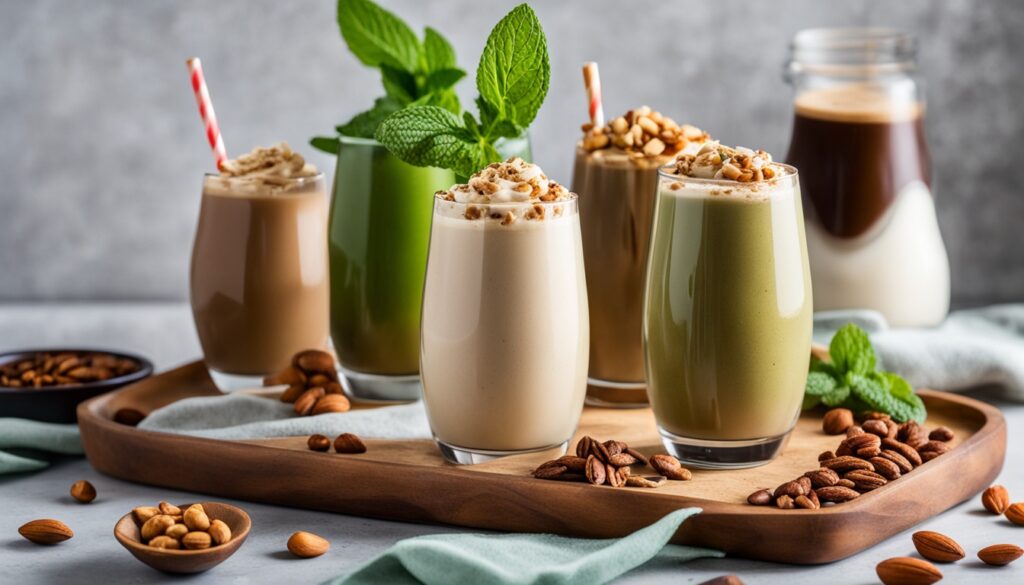
How to Make Coffee Ice Cubes for Your Recipes
Making coffee ice cubes can really change how coffee lovers enjoy their drinks. These cubes cool drinks without watering them down. They also improve various recipes. This guide will show you how to brew strong coffee, freeze it into cubes, and add them to smoothies and shakes.
Instructions for Brewing and Freezing Coffee
To make tasty coffee ice cubes, just follow these steps:
- Choose Your Coffee: Pick a brewed coffee type, like cold brew, drip, or pour-over. Each kind gives a unique flavor to the ice cubes.
- Prepare Coffee: Brew the coffee strong for the best flavor. For cold brew, let it steep around 20 hours.
- Cool the Coffee: Let the brewed coffee cool to room temperature before freezing. This helps it freeze evenly.
- Flavor It Up: Add extra flavors like caramel or mocha if you want. Sweeteners like maple syrup can also be mixed in for a special taste.
- Fill Ice Trays: Pour the cool coffee into ice cube trays. For a creamy touch, use almond or oat milk.
- Freeze: Put the trays in the freezer until the coffee is solid, about 3-4 hours.
- Store: Keep the coffee ice cubes in the freezer. They can last up to two weeks but check them over time.
KitchenAid® has all kinds of coffee makers and tools to make this fun project easier. Trying different coffees and flavors lets everyone enjoy their own custom coffee ice cubes in smoothies or shakes.

Conclusion
Adding pre-workout coffee recipes to a workout routine has many benefits. Over 73% of athletes use caffeine for a better performance. Coffee can boost endurance and focus during training. It also raises energy levels, making exercise more fun for everyone.
We looked at different coffee protein shake recipes. They range from cool iced coffees to warm mocha drinks. Drinking one about 45 to 60 minutes before exercise is best. This is when caffeine effects are strongest, helping you through your workout.
These coffee recipes are not just about energy. They bring new, tasty options for fitness fans. With so many choices, coffee enthusiasts can enjoy their drink and reach fitness goals. This makes workouts both fun and effective. Home barista coffee recipes can provide a unique and delicious way to enjoy coffee while also staying healthy and active. From protein-packed iced lattes to antioxidant-rich espresso smoothies, there are endless possibilities to create drinks that fuel the body and satisfy the taste buds. By experimenting with different ingredients and flavors, home baristas can elevate their coffee experience and make their fitness journey even more enjoyable.
